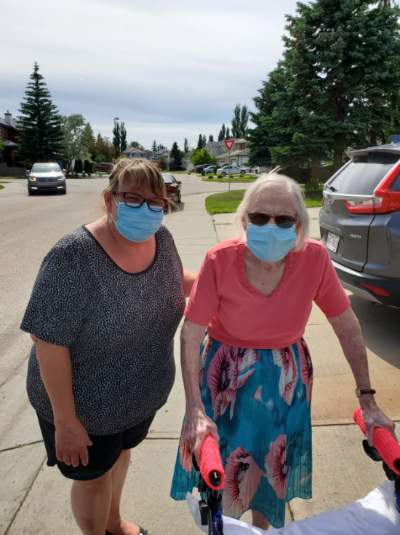Dora Mackay is still fiercely independent.

At 95 (and a half), she washes her own hair and spends countless hours focused on genealogy. It has helped keep her mind sharp.
When her 70-year-old son Charles Mackay suggested she move out of her long-term care home last March and into his home, Dora didn’t want to go.
Her friends and activities were a big part of her life, but Charles was watching COVID-19 spread rapidly through the United States and the alarming number of elderly people dying from the disease.
“The risks were quite ominous at the time,” said Charles. “So we decided it wasn’t really safe to stay there. As it turned out, things deteriorated rapidly in all of the centres, not just hers.
“It wasn’t a tough decision.”
READ MORE: Has COVID-19 changed the way people of long-term care?
The setup at his home also helped.
Dora moved into the spare room on the main floor, across from a bathroom. She didn’t have to navigate stairs inside the home.
Charles and his newlywed wife made adjustments. They gave up some privacy, and every meal and dose of medication was now up to them.
To protect Dora from COVID-19, visitors have not been allowed in the home and they decided against home care, but Charles said he has no regrets.
“It’s not a big step, she’s our mother. And the risk of her staying in the home was much too great.”

Get weekly health news
If not COVID itself, the family feared what isolation would do to Dora.
“Now they’re just isolated in their room, something terrible,” said Charles. “I really feel sorry for the people still there.”
Dr. Dawn Stacey, a professor in the School of Nursing at the University of Ottawa and senior scientist at the Ottawa Hospital Research Institute, said COVID outbreaks have been rampant in long-term care homes across Canada, and more and more families are reassessing care.
“Many families are reconsidering whether or not long-term care is actually meeting the needs of their family given that they’re isolated in their own rooms.”
Stacey said bringing a loved one home is not a straightforward decision.
At the beginning of the pandemic, Stacey helped develop a Patient Decision Aid — which was supposed to be a guide to help people think through a temporary move. Ten months later, families are looking long-term.
Although the checklist is geared toward people living in Ontario, Stacey said anyone can use the form to determine if they and their home are suitable for their loved ones’ care needs.
These are just a few of the questions Stacey said you should ask yourself:
- Who would be on the night shift responding to someone calling out or wandering or needing to use the toilet?
- Are there grab pulls to make it easier for bathing or showering?
- How many stairs does it take to get into the house?
If you decide to bring your loved one home, Stacey stressed it’s important to know the rules in your province.
This past spring, Stacey said Ontario allowed people to move out of long-term care homes temporarily and while they may not get their same room, they would be given higher priority once they decided to move back.
That is not the case in every province.
Until the vaccination is delivered, Stacey said it’s critical to limit exposure in your personal home, which could include home-care professionals.
“There still is some risk.”
Dora, who had been in long-term care since 2016, had only planned on staying at her son’s for a short time — she has since moved everything out of long-term care and Charles said once the vaccinations are fully delivered, they will reconsider.
As for Dora, she said she’s learned a few things about her son as well.
“He’s as forgetful as I am.”










Comments